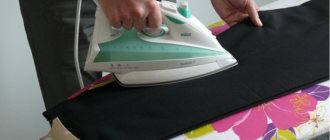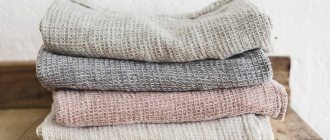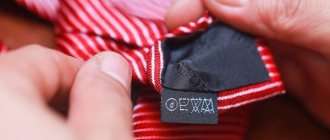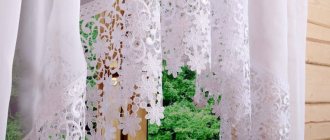Tulle is widely used in interior decoration. But, this material is capricious and needs careful care.
Almost every housewife has at least once faced the question - is it necessary to iron tulle? To answer this question, determine what the curtain is made of.
In this article we will tell you how to quickly iron tulle from various fabrics: in what mode, at what temperature, and what can be used for ironing, except an iron.
General ironing rules
Some tips:
- Iron only with a clean iron. To prevent the tulle from having to be washed again, there should be no dirt on the sole of the iron.
- To avoid damaging thin fabric, use a padding such as slightly damp gauze.
- Do not wait for the tulle to dry completely. Start ironing while it is slightly damp.
- While ironing, fold the curtain in several layers, but do not iron the folds.
- To avoid stains and streaks on the tulle, do not wet the tulle with tap water.
About history and subtleties
Tulle got its name from the French city where they first learned to produce this fabric back in the Middle Ages. The second name for tulle is bobinette. It contains paper threads, which makes care somewhat more difficult, making the material very susceptible to high temperatures.
Tulle curtains are present in almost every home. They are the first to attract attention when people walk into a room. By the choice of curtains, one can judge the tastes of the owners, since a successful version of elegant tulle curtains will favorably emphasize even a simple interior, but too catchy and provocative tulle on the windows will ruin the impression hopelessly. In order for tulle to remain light and elegant for a long time, it should be properly cared for: washed and ironed. On average, these manipulations are carried out 2 times a season. And if washing is not particularly difficult, since an automatic machine can easily handle delicate fabric, then ironing is more difficult. Thin tulle is not only resistant to a hot iron, but its dimensions are impressive when it comes to curtains. Here are some recommendations to help you cope with the task.
How to iron tulle from different materials
To make tulle, natural and synthetic materials are used, which require different temperature conditions. Before you begin, read the care instructions on the label - some manufacturers indicate the optimal ironing temperature on it.
Cotton and linen
Cotton or linen tulle is ironed damp. If the curtain is dry, moisten the folds and creases with water from an iron or spray bottle. It is better to iron these fabrics from the wrong side.
As a rule, natural materials are not afraid of high temperatures, but if possible, do not heat the iron above 120°C.
Wet curtains made of linen and cotton can be immediately hung on the cornice. In rooms with warm air, they will take the desired shape under the weight of their own weight.
Silk
Silk tulle will smooth out if you hang it wet on the curtain rod. But if there are creases on the fabric, you will have to use an iron. It is better to iron from the inside out at a minimum temperature - no more than 80°C. You need to additionally protect the fabric: place a white sheet of paper under the tulle and cover the curtain with a second sheet or gauze. Do not use a spray bottle as it will leave streaks on silk fabrics.
Organza
This is a very thin and capricious material, so it is important to take care of ironing at the washing stage. Procedure for working with organza:
- rinse the tulle in salted water (25 g of salt per 5 liters of water) to protect it from wrinkles;
- wait until the curtain is completely dry;
- lay the fabric on the ironing board, smooth out the folds;
- place paper or fabric under the organza; it is better to use white cotton so that the design does not imprint on the tulle;
- cover the organza with a sheet of paper, gauze or thin cloth;
- Set the iron to the lowest temperature possible to avoid burning or melting the fibers.
Organza may lose its shape, so it is important not to pull on the fabric when ironing. Do not use a steamer, otherwise the fabric will become deformed and wavy.
Capron
Before ironing nylon tulle, make sure that there are no stains or dirt left on the fabric. Under the influence of high temperature, the stains will be imprinted into the nylon and become even brighter. If you are unable to remove the stains yourself, hold off on ironing and take the tulle to the dry cleaner.
The optimal temperature for ironing is no more than 110°C. Just in case, check the reaction of the fabric to the selected temperature in an inconspicuous area. If it has not deteriorated, proceed to ironing.
Nylon is ironed dry or slightly damp. You should not use steam, otherwise the fabric will lose its shape. Put a special attachment on the iron or iron the curtain through a cotton fabric - do not touch the fragile fabric with the metal sole of the iron.
Polyester
Polyester tulle is susceptible to creases even with a gentle wash cycle. To get rid of wrinkles, iron the curtain while damp. Do not exceed the temperature of 80°C; iron the fabric through gauze.
Viscose
To preserve color, iron viscose from the inside out. Set the temperature to no higher than 120°C and additionally check the reaction of the fabric in an inconspicuous area. It is better to iron the curtain through a piece of cotton.
You can straighten viscose fabric vertically using a steam generator. Do not steam viscose in a horizontal position, otherwise it will become deformed and waves will appear on the fabric.
Voile and mesh
Curtains made of voile or mesh are ironed slightly damp. It is much more difficult to smooth out wrinkles on dry tulle.
Process voile and mesh fabrics on the ironing board from the wrong side. You can heat the iron up to 150°C, but you need to iron the curtains through damp gauze. Before hanging the tulle, make sure that the fabric is completely dry during the ironing process.
Velvet
A very capricious fabric, which, if not properly cared for, immediately loses its texture and becomes deformed. If the curtains are like this, the best thing to do is to have them dry cleaned.
This may not save money on maintenance, but at least you won’t have to buy a new product.
The thing is that the delicate pile does not tolerate long contact with water, it immediately deforms, the structure itself is also capable of stretching, so spinning is out of the question.
If you still have to wash it yourself, it is better to refuse the machine. At least some housewives still practice this method.
- It should be placed in a bath, water no more than 30, turn the fabric out so that the pile is in the middle.
- When washing, you should not wrinkle or rinse vigorously; everything should be gentle and careful. Also, when squeezing, there are no tourniquets as with ordinary things.
- Next, another point is drying. Here you will need a large vertical surface so that you can spread them out. There should be no folds, as they will leave bald spots.
- A blanket or sheet is placed under the fabric so that it can absorb water; it must be changed periodically. Hang slightly damp.
How to iron large tulle
There are several ways:
- Place the curtain on the ironing board and gently slide it down. When the ironed edge of the tulle touches the floor, hook it to the hook of the curtain rod and work the remaining area. Move the fabric with the cornice so that the tulle does not wrinkle or get dirty.
- Fold the tulle several times, but do not iron the folds. When you have ironed the fabric on all sides, run the iron over the unironed areas.
- Use a wide board and a round stick. Wrap the fabric around the board and iron it. Wrap the ironed part of the curtain around a stick, making sure that no unevenness is formed.
General recommendations
- When the product is removed from the ledge, if possible, it is necessary to shake it out. This will allow you to get rid of most of the dust, and the dust that has clogged up in the structure will come to the surface, which will contribute to better cleaning;
- To remove dust, it is not necessary to use powder. As a rule, this is an aggressive environment that does not have a very favorable effect on the structure. You can use shampoo, it has a mild effect, but is no less effective.
- Often models have decor, embroidery, beads, and others. They can easily get damaged in the drum, so be sure to use a bag. If it is a very delicate decor, it is better to use hand washing.
- There should be no other things in the drum. In addition, it should not be overloaded, as this will significantly reduce the quality of the wash. If the models are large, wash in separate parts if possible.
- If you have doubts about the material, it is better not to take risks with the cleaning method. Perhaps, for the first time, just go to a dry cleaner, where they will tell you how to care for them.
- There is no need to create a specific schedule for water procedures. These products must be washed when dirty. If we consider that the most important factor that affects cleanliness is dust, then a lot depends on wet cleaning in the apartment. The time of year also matters. If it is summer, windows and balconies are constantly open, which accordingly increases the possibility of pollution.
In the kitchen, curtains and drapes require more frequent maintenance.
How to iron tulle by weight
If there are no wrinkles on the fabric after washing, do not wring it out, but hang it over the bathtub so that the water can drain. You can fill a basin or bathtub with boiling water - the fabric will smooth out under the influence of steam. Then hang the tulle on the curtain rod and smooth it out with your hands.
You can also iron tulle vertically using an iron. Hang the tulle on the curtain rod and set the steam function. Move the device vertically as close to the curtain as possible without touching it. Move from top to bottom.
Be careful: heat treatment can only be applied to durable natural fabrics.
Polyester
Quite practical and durable material. It can be safely machine washed, but it is still better to follow some rules.
The thing is that, despite the strength, large loads on the surface can cause harm.
But the harm is that with strong impact, the material will wrinkle, and since it is light in weight, drying will not help smooth it out. You'll have to use an iron and waste time.
- It's better to use a bag;
- Wash separately from any other items;
- Use no more than 40;
- “Delicate” mode;
- No spin.
It is necessary to choose a place where the water can drain into the container, then hang it and smooth it out.
If you follow these points, the surface will be perfectly smooth and you won’t need to remember about the iron.
How to steam tulle
Follow the instructions:
- pour water into the steamer compartment;
- hang the tulle on the cornice;
- run the steamer over the fabric from top to bottom.
Pay special attention to places with creases and folds. Repeat the manipulation until the fabric is completely flattened.
This method is contraindicated for silk - steaming may result in streaks and stains. The method is also not suitable for organza and nylon due to the risk of fabric deformation.
We use a steamer
Compared to the newest iron, the steamer wins on many counts. This useful device can significantly ease household chores .
Thanks to him, housewives can get rid of many labor-intensive manipulations. Unlike irons, this device produces steam that affects textiles.
The steamer has its advantages:
speed and quality of ironing;- the final result is absolutely not affected by the shape of the products and their material;
- together with the smoothing process, the fabric is disinfected, grease stains are removed and linen is cleaned;
- in addition to dirt and greasy stains, unpleasant odors, allergens and pathogens are eliminated;
- There is no need to remove curtains during ironing.
Steamer usage:
- Clean water is poured into a special reservoir of the device.
- The curtain is hung on the cornice.
- You need to run a steamer over the curtain from top to bottom. Places where tissue is creased deserve special attention.
- If necessary, the process can be repeated again.
This ironing method is not suitable for silk tulle, as steam may cause stains and streaks to appear on this fabric.
A steamer costs a lot of money, so if you need it 1-2 times a year, it is better to rent it or ask friends.
How to starch fabric
Starched fabric retains its appearance longer, practically does not get dirty, holds its shape well and does not wrinkle. To starch white tulle:
- prepare a classic paste: dissolve 30 g of starch in 200 ml of cool water;
- pour the resulting solution into 500 ml of boiling water, stir well;
- add the product to the water when rinsing;
- soak the curtains for 15–20 minutes, and then remove and hang the tulle over the bathtub to drain off excess liquid.
After starching, iron slightly damp curtains in a manner suitable for the fabric.
Important care points
Have you ever wondered how to wash curtains so that they do not lose their texture, color and shape? And this primarily affects their condition.
When curtains are purchased, many simply do not have labels indicating the permissible water temperature for washing and whether they can be ironed at all.
Sometimes such recommendations are given by the sellers themselves, but, unfortunately, in rare cases.
For example, there is a structure that requires only hand washing and gentle spinning; if you wash it in a machine, it will lose its appearance and even an iron will not help to return it.
So, let's start in order, consider how and what materials to wash, because it is this procedure that directly affects their condition and ironing.
Main
- Cotton and linen fabrics do not need to be ironed. It needs to be hung wet on the eaves - it will straighten out under its own weight.
- When choosing an ironing method, consider the type of material. Most fabrics do not tolerate high temperatures and require ironing through paper, gauze or cotton cloth.
- Many types of fabrics can be ironed while wet, but it is better to dry organza and nylon before processing.
- Do not wring out the tulle. Housewives advise hanging the material over a bathtub or boiling water to drain off excess liquid.
Thread curtains
The question here is not how not to iron, but how to prevent knots and tangling. Well, first of all, it’s worth saying that with their delicate appearance and delicate structure, they tolerate water treatments in a machine very well, they just require a little preparation:
- Along the entire length, it is necessary to tie with ropes;
- Next place in a bag;
- Temperature up to 40;
- Gentle mode;
- And medium spin.
But they need to be dried immediately on the ledge; due to their lightness, they will not take long to dry, but they will quickly return to their original appearance.
Summing up, we can say with confidence that ironing is directly related to the material and washing, without making mistakes, unnecessary manipulations with the iron will not be required.











